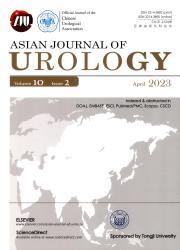Comparison between 18F-DCFPyL PET/MRI-guided ultrasound fusion targeted biopsy and systematic biopsy for tumor detection and grading in selected patients: A prospective randomized controlled trial
IF 2.4
3区 医学
Q2 UROLOGY & NEPHROLOGY
引用次数: 0
Abstract
Objective
This study aimed to compare the upgrade rate and cancer detection rate between the 18F-DCFPyL PET/MRI-guided ultrasound fusion targeted biopsy (TB) and systematic biopsy in selected patients with suspected prostate cancer (the molecular imaging prostate-specific membrane antigen score of ≥2 and multiparametric MRI Prostate Imaging Reporting and Data System score of ≥4).
Methods
Eighty-seven selected biopsy-naive patients were randomized into two groups: TB (n=41) and systematic biopsy (control; n=46). Patients diagnosed with clinically significant prostate cancer proceeded to radical prostatectomy. The primary outcome was the pathological upgrade rate. Secondary outcomes, including the cancer detection rate, incidence of repeat biopsy, positive surgical margin, complications, and prostate-specific antigen level at 6 weeks postoperatively, were compared between the groups using the Pearson or Fisher's exact test, as appropriate.
Results
In the study, prostate cancer was ultimately detected in all patients. The TB group successfully identified all tumors, whereas five patients in the control group initially missed diagnosis. The pathological upgrade rates for the TB and control groups were 31.7 % and 56.5%, respectively. Overall, the detection rate for clinically significant prostate cancer (the International Society of Urological Pathology grade of ≥2) was significantly higher in the TB group (92.7%) compared with the control group (76.1%, p=0.035). However, no significant difference was found in the detection rate of all prostate cancer. Complications (Clavien–Dindo grade of ≤2) occurred in both the TB group (n=11) and control group (n=13). No statistically significant difference was observed between the groups in terms of the positive surgical margin, complications, or 6-week postoperative prostate-specific antigen level.
Conclusion
The 18F-DCFPyL PET/MRI-guided ultrasound fusion TB alone was an efficient modality in diagnosing selected patients with prostate cancer.
一项前瞻性随机对照试验:18F-DCFPyL PET/ mri引导下超声融合靶向活检与系统活检在特定患者肿瘤检测和分级中的比较
目的比较18F-DCFPyL PET/MRI引导下超声融合靶向活检(TB)与系统活检对疑似前列腺癌(分子成像前列腺特异性膜抗原评分≥2分、多参数MRI前列腺成像报告和数据系统评分≥4分)患者的升级率和癌检出率。方法选择87例首次活检患者随机分为两组:TB组(n=41)和系统活检组(对照组;n = 46)。诊断为临床显著前列腺癌的患者进行根治性前列腺切除术。主要观察指标为病理升级率。次要结局,包括癌症检出率、重复活检发生率、手术切缘阳性、并发症和术后6周前列腺特异性抗原水平,采用Pearson或Fisher精确检验(视情况而定)比较两组之间的差异。结果在本研究中,所有患者最终均检出前列腺癌。结核病组成功地发现了所有肿瘤,而对照组中有5名患者最初未被诊断出来。结核组和对照组的病理升级率分别为31.7%和56.5%。总体而言,TB组临床显著性前列腺癌(国际泌尿病理学会分级≥2级)的检出率(92.7%)显著高于对照组(76.1%,p=0.035)。然而,所有前列腺癌的检出率没有明显差异。TB组(n=11)和对照组(n=13)均出现并发症(Clavien-Dindo分级≤2)。两组在手术阳性切缘、并发症、术后6周前列腺特异性抗原水平方面无统计学差异。结论单纯18F-DCFPyL PET/ mri引导下超声融合TB是诊断特定前列腺癌患者的一种有效方式。
本文章由计算机程序翻译,如有差异,请以英文原文为准。
求助全文
约1分钟内获得全文
求助全文
来源期刊

Asian Journal of Urology
UROLOGY & NEPHROLOGY-
CiteScore
4.00
自引率
3.80%
发文量
100
审稿时长
4 weeks
期刊介绍:
Asian Journal of Urology (AJUR), launched in October 2014, is an international peer-reviewed Open Access journal jointly founded by Shanghai Association for Science and Technology (SAST) and Second Military Medical University (SMMU). AJUR aims to build a communication platform for international researchers to effectively share scholarly achievements. It focuses on all specialties of urology both scientifically and clinically, with article types widely covering editorials, opinions, perspectives, reviews and mini-reviews, original articles, cases reports, rapid communications, and letters, etc. Fields of particular interest to the journal including, but not limited to: • Surgical oncology • Endourology • Calculi • Female urology • Erectile dysfunction • Infertility • Pediatric urology • Renal transplantation • Reconstructive surgery • Radiology • Pathology • Neurourology.
 求助内容:
求助内容: 应助结果提醒方式:
应助结果提醒方式:


